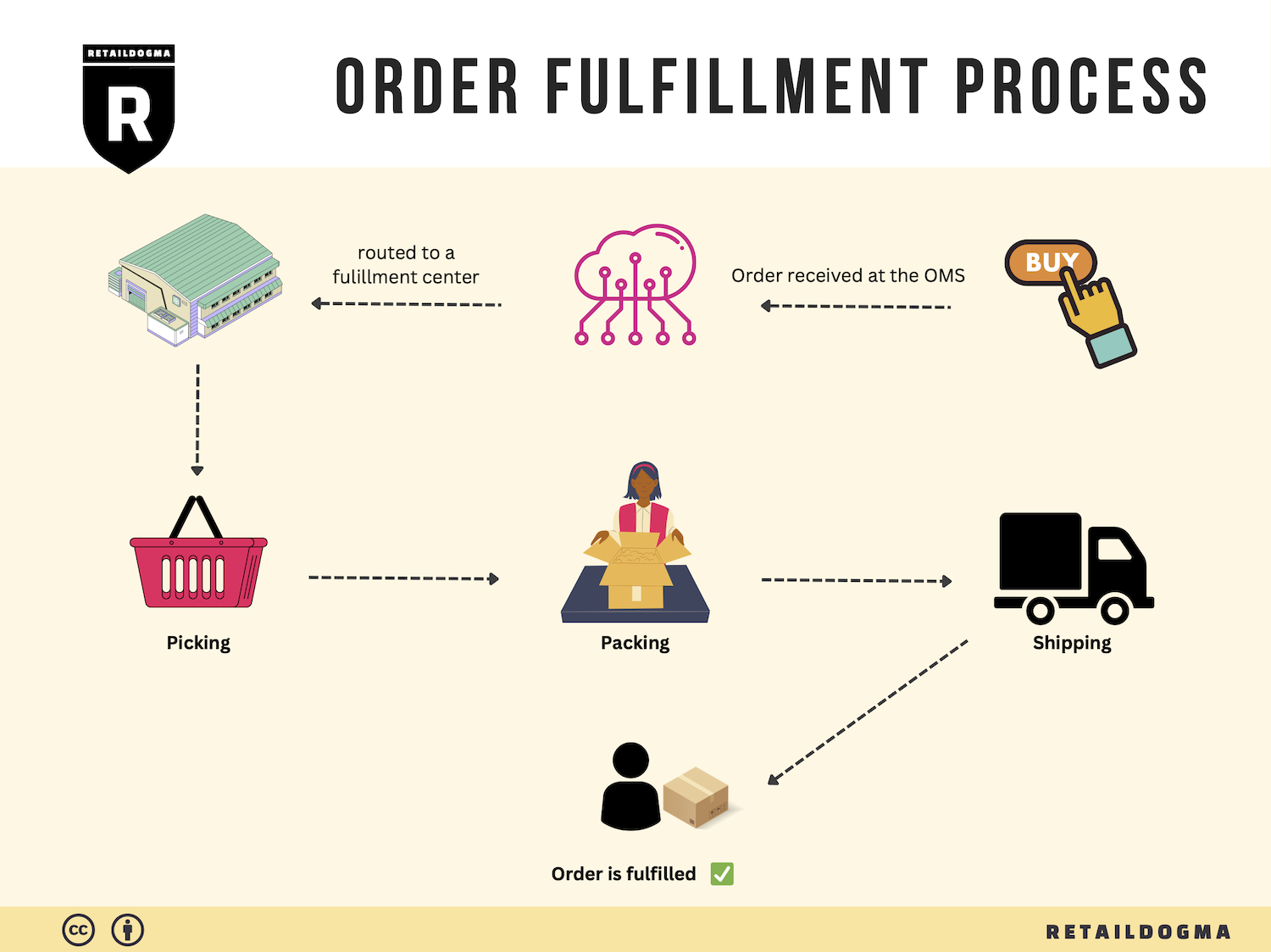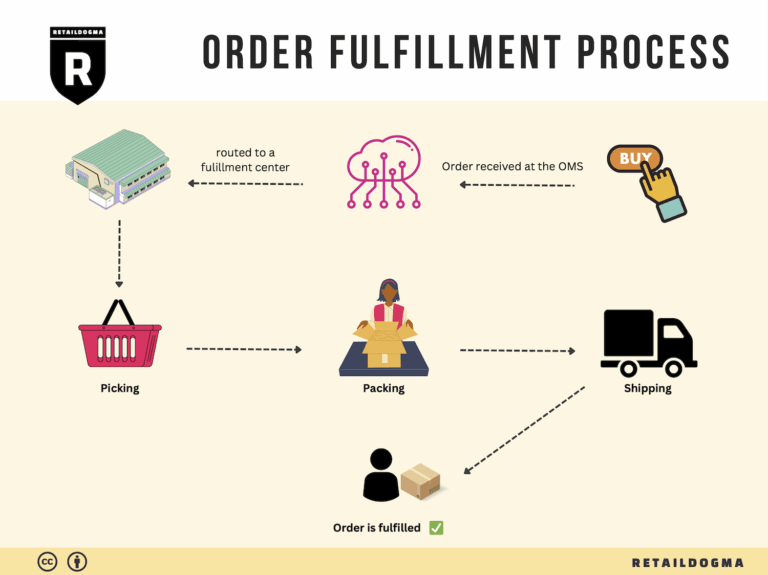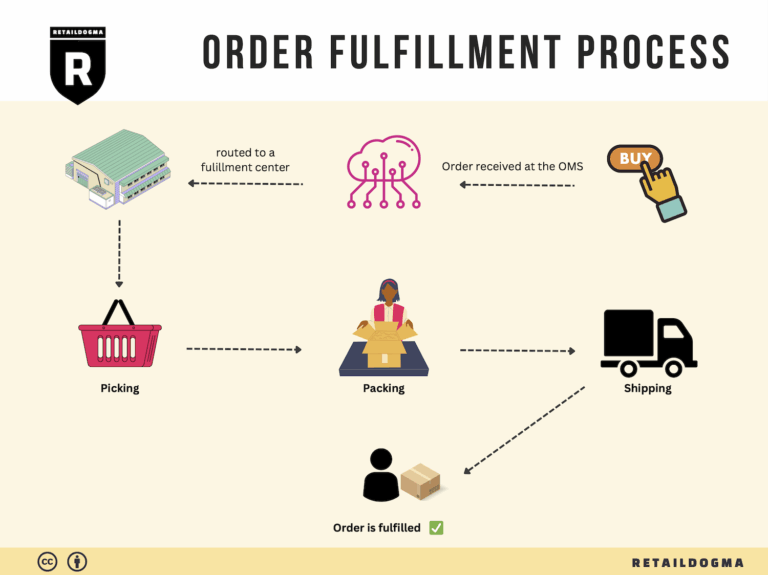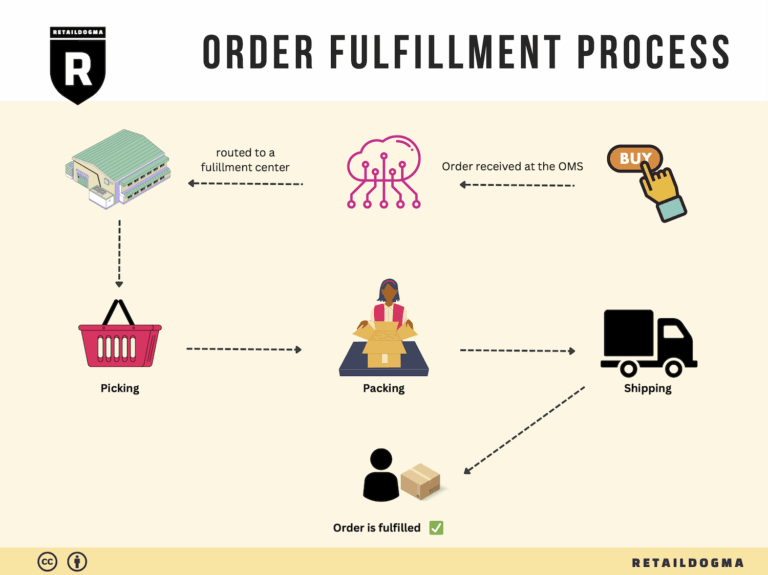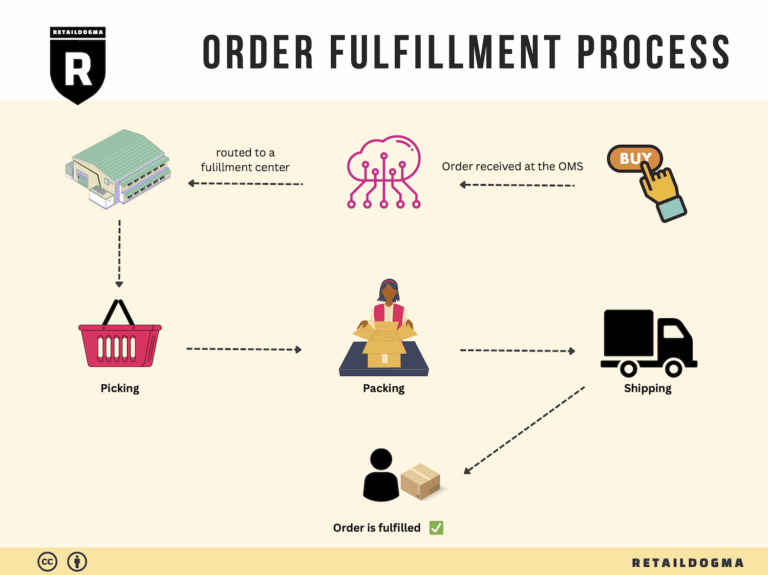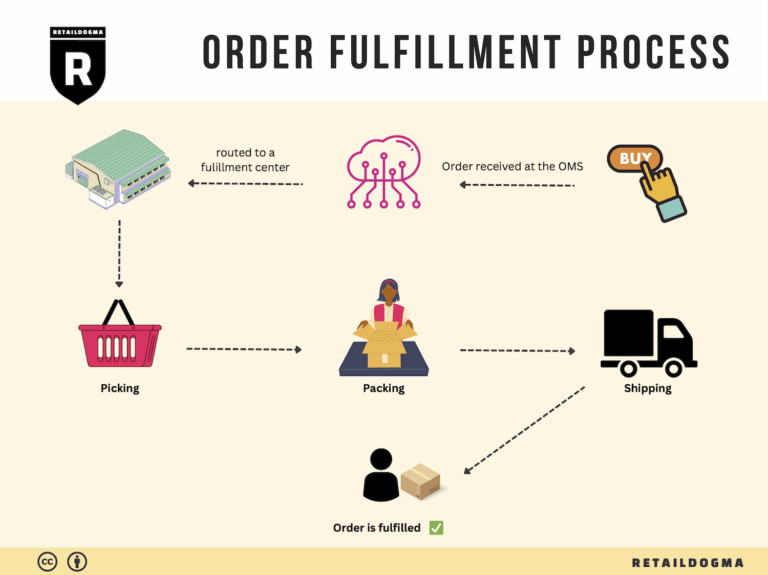How Order Fulfillment Works: A Step-by-Step Guide for Businesses
What is E-commerce Fulfillment? An Introduction for Growing Businesses
Understanding E-commerce Fulfillment: A Solution to Common Pain Points
As your online business begins to grow, the excitement of increasing sales can quickly turn into the stress of managing order fulfillment. Packing and shipping orders can feel overwhelming, especially when you are trying to maintain quality customer service while scaling operations. This is where understanding e-commerce fulfillment becomes crucial.
At its core, fulfillment refers to the entire process of getting a product from your inventory to your customer’s doorstep. It encompasses everything from inventory management and order processing to packaging and shipping. For many growing businesses, mastering this process is essential to sustaining growth and ensuring customer satisfaction.
In this guide, we will delve into the various fulfillment models available to e-commerce businesses, such as Third-Party Logistics (3PL) and Fulfilled by Amazon (FBA). Each model has its own advantages and considerations, and understanding these will help you determine the best fit for your business needs.
Additionally, we will cover the core services that fulfillment partners typically offer. This includes warehousing, order management, shipping solutions, and even customer service support. Knowing what services are essential for your operation can save you time and resources, allowing you to focus on other areas of your business.
Choosing the right fulfillment partner is another critical decision that can impact your business’s efficiency and customer experience. We will provide insights into the criteria you should consider when evaluating potential partners, such as their technology capabilities, scalability, and customer service reputation.
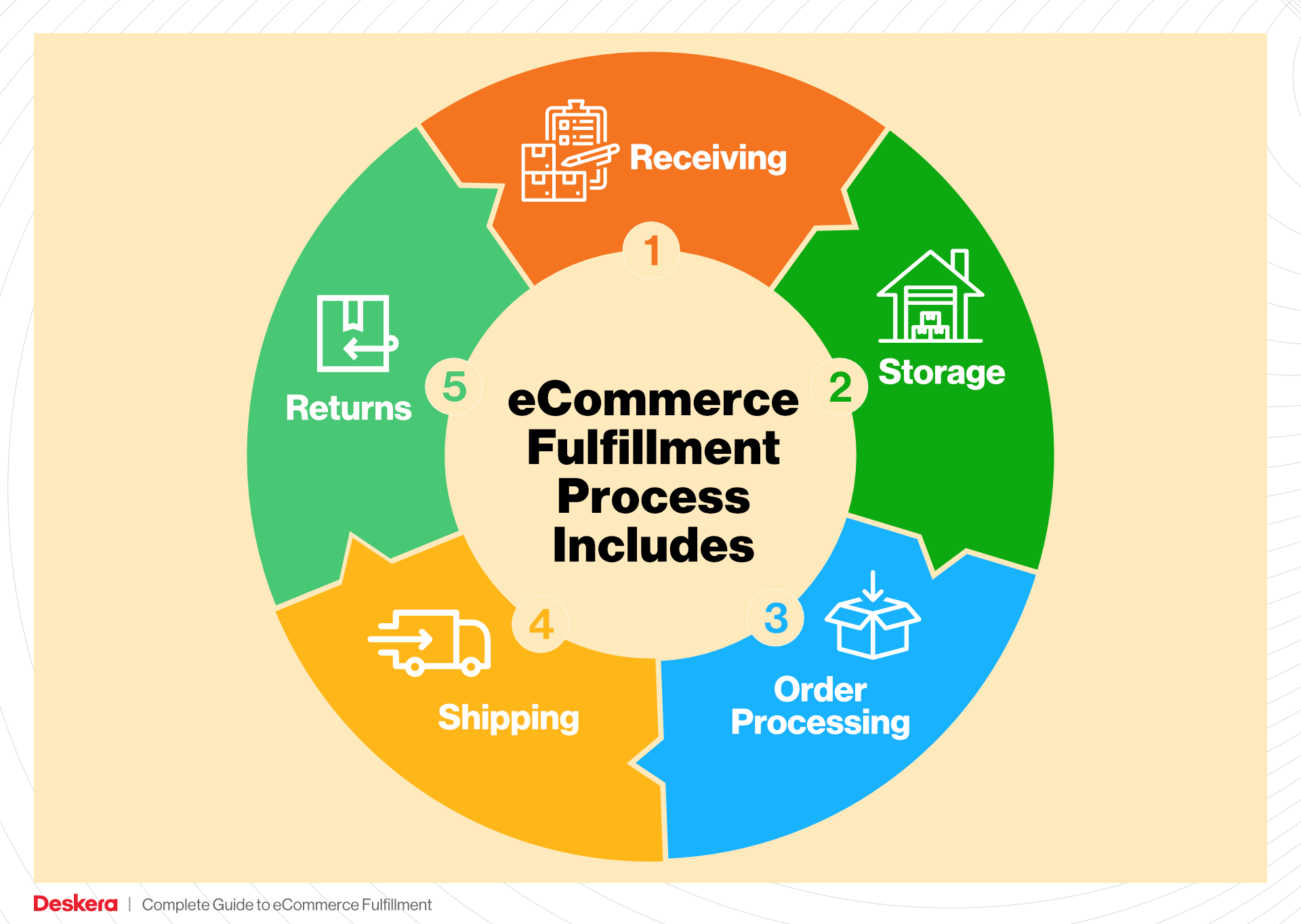
Finally, pricing models in fulfillment can vary widely, and understanding these costs is vital for budgeting and maximizing your profit margins. We will break down the typical pricing structures you may encounter, helping you make informed financial decisions.
The goal of this guide is to empower your business to make smart, strategic decisions regarding logistics and fulfillment. By gaining a clear understanding of the fulfillment landscape, you will be better equipped to handle the challenges of growth, streamline your operations, and ultimately enhance your customers’ experience.
What You’ll Learn In This Guide
- What is E-commerce Fulfillment? An Introduction for Growing Businesses
- The Order Fulfillment Process: From ‘Buy’ Button to Customer’s Door
- Comparing Fulfillment Models: In-House vs. 3PL vs. Dropshipping
- A Deep Dive into Amazon FBA: Pros, Cons, and Who It’s For
- Core Services Offered by Fulfillment Centers
- How to Choose a Fulfillment Partner: A 6-Point Checklist
- Understanding Fulfillment Pricing: A Breakdown of Common Fees
- Frequently Asked Questions (FAQs) about Fulfillment
- Conclusion: Is Outsourcing Fulfillment the Right Move for Your Business?
- Important Disclaimer
The Order Fulfillment Process: From ‘Buy’ Button to Customer’s Door
1. Receiving Inventory
The order fulfillment process begins with the receiving of inventory. This is the stage where products are delivered to the fulfillment center from suppliers or manufacturers. Upon arrival, each item is inspected for quality and quantity against the purchase order to ensure accuracy. This step is crucial because discrepancies at this stage can lead to stockouts or excess inventory, both of which can severely impact sales and customer satisfaction.
Key terms associated with this step include SKU (Stock Keeping Unit), which is a unique identifier for each product. Utilizing SKUs allows for efficient tracking of inventory levels and facilitates streamlined inventory management. Properly receiving inventory not only sets the foundation for the fulfillment process but also ensures that the stock is organized and ready for subsequent steps.
2. Warehouse Storage
After receiving the inventory, the next step is warehouse storage. This involves placing the products into designated storage areas within the fulfillment center. Items are often stored based on their SKU, size, and demand frequency, allowing for optimal space utilization and easy accessibility.
Effective warehouse storage is vital for minimizing order picking times and ensuring a smooth flow of goods. Proper categorization can significantly reduce the time it takes to locate items when orders come in. This step often employs ABC analysis, a method of categorizing inventory based on its importance and turnover rate, ensuring that high-demand items are easily accessible.
3. Order Picking
Once a customer places an order, the fulfillment process moves to order picking. This step involves retrieving the correct items from the warehouse to fulfill the order. Pickers typically use pick lists, which detail the items and quantities needed for each order. This can be done manually or through automated systems, depending on the scale of operations.
Order picking is a critical component of the fulfillment process because it directly affects order accuracy and speed. Efficient picking processes can reduce labor costs and improve customer satisfaction by ensuring timely deliveries. Strategies like batch picking—where multiple orders are picked simultaneously—can enhance efficiency, especially during peak seasons.

4. Order Packing
Once items are picked, they move to the packing stage. Here, products are carefully packaged to ensure they arrive safely at the customer’s location. This involves selecting the appropriate packaging materials, labeling the packages, and including any necessary documentation, such as invoices or return instructions.
Packing is essential for protecting products during transit and reducing the likelihood of returns due to damage. Additionally, efficient packing processes can save on shipping costs by minimizing dimensional weight charges. Key terms in this step include dimensional weight pricing, which is a pricing technique used by carriers to calculate shipping costs based on package size rather than weight.
5. Shipping & Delivery
The final step in the order fulfillment process is shipping and delivery. Once packed, orders are handed over to shipping carriers for delivery to the customer’s address. This stage involves selecting the best shipping method based on cost, speed, and reliability.
Timely shipping is crucial for maintaining customer satisfaction and trust. Businesses often utilize tracking numbers to provide customers with real-time updates on their order status, enhancing the overall customer experience. Efficient shipping practices not only improve delivery times but also enable businesses to scale operations by optimizing logistics and reducing costs.
By understanding and optimizing each step of the order fulfillment process, e-commerce businesses can enhance operational efficiency, improve customer satisfaction, and ultimately drive growth. Implementing best practices in inventory management, warehouse storage, order picking, packing, and shipping can set your business apart in a competitive landscape.
Comparing Fulfillment Models: In-House vs. 3PL vs. Dropshipping
Fulfillment Models Comparison
| Model | Who Handles Inventory | Best For (Business Stage) | Key Advantage | Key Disadvantage |
|---|---|---|---|---|
| In-House Fulfillment | The business itself | Established businesses with stable sales | Full control over inventory and processes | High overhead costs and staffing requirements |
| Third-Party Logistics (3PL) | A third-party provider | Growing businesses needing scalability | Flexibility and reduced operational burden | Less control over inventory and potential service quality issues |
| Dropshipping | Supplier or manufacturer | Startups and small businesses | Low startup costs and no inventory management | Lower profit margins and reliance on supplier reliability |
In-House Fulfillment
In-house fulfillment involves managing your own inventory and logistics directly within your business. This model is typically adopted by established businesses that have reached a stable sales volume and want complete control over their fulfillment processes. The primary advantage of in-house fulfillment is the ability to maintain direct oversight of inventory, quality control, and the overall customer experience. Businesses can customize their processes to align with their brand identity and service standards, which can lead to greater customer satisfaction. However, this model comes with significant disadvantages, such as high overhead costs associated with warehousing, staffing, and maintaining inventory. Moreover, as sales grow, scaling operations can become complex and resource-intensive. Businesses must also manage the risks associated with inventory management, such as overstocking or stockouts, which can impact cash flow and customer satisfaction.
Third-Party Logistics (3PL)
Third-party logistics (3PL) is a model where businesses outsource their inventory management and fulfillment processes to a specialized provider. This option is particularly beneficial for growing businesses that require scalability and flexibility without the capital investment associated with in-house operations. A key advantage of using a 3PL provider is the reduction of operational burdens; businesses can focus on core activities like marketing and product development while leaving logistics to experts. 3PL providers often have established networks, advanced technology, and expertise that can enhance efficiency and reduce shipping times. However, this model also has its drawbacks, such as a potential loss of control over inventory management and fulfillment processes. Businesses may encounter challenges related to service quality, especially if the 3PL provider does not meet expectations or if there are communication issues. It is crucial for businesses to choose a reliable 3PL partner and establish clear performance metrics to ensure alignment with their operational goals.
Dropshipping
Dropshipping is a fulfillment model where businesses sell products without holding any inventory. Instead, when a customer places an order, the business purchases the item from a supplier or manufacturer, who then ships it directly to the customer. This model is particularly appealing for startups and small businesses due to its low startup costs and minimal financial risk. Entrepreneurs can launch their businesses without the burden of inventory management, allowing them to focus on marketing and customer engagement. However, dropshipping comes with several disadvantages, including lower profit margins since suppliers often charge higher wholesale prices. Additionally, businesses must rely heavily on their suppliers for product quality, shipping speed, and inventory availability, which can lead to customer dissatisfaction if issues arise. As a result, maintaining a consistent and reliable customer experience can be challenging in the dropshipping model, particularly during peak sales periods or when suppliers face disruptions.
Conclusion
Choosing the right fulfillment model is critical for e-commerce success and depends on various factors, including business size, growth stage, and operational capabilities. In-house fulfillment offers control but requires significant investment, while 3PL provides flexibility at the cost of some oversight. Dropshipping lowers financial risk but can lead to challenges in customer satisfaction. Business owners must carefully evaluate their unique needs and market conditions to select the most suitable fulfillment strategy for scaling their operations.
A Deep Dive into Amazon FBA: Pros, Cons, and Who It’s For
Understanding Fulfillment by Amazon (FBA)
Fulfillment by Amazon (FBA) is a service provided by Amazon that allows sellers to store their products in Amazon’s fulfillment centers. Amazon then takes care of storage, packaging, and shipping of these products, as well as customer service and returns. This service is particularly attractive for e-commerce businesses looking to scale their operations without investing heavily in logistics infrastructure.
When a customer places an order for a product fulfilled by Amazon, the company picks, packs, and ships the product directly to the customer. Sellers benefit from Amazon’s extensive logistics network and can leverage Amazon’s customer service, allowing them to focus more on growing their business rather than managing day-to-day shipping operations.
How FBA Works
-
Sign Up for FBA: Sellers create an Amazon Seller account and enroll in the FBA program. This involves agreeing to Amazon’s terms and conditions and setting up shipping options.
-
Prepare Products: Sellers must prepare their products according to Amazon’s guidelines, which include labeling and packaging requirements. This ensures that items are ready for efficient storage and shipping.
-
Ship Inventory to Amazon: Once products are prepared, sellers ship them to Amazon’s fulfillment centers. Amazon provides specific instructions on where to send inventory based on the seller’s location and the products being sold.
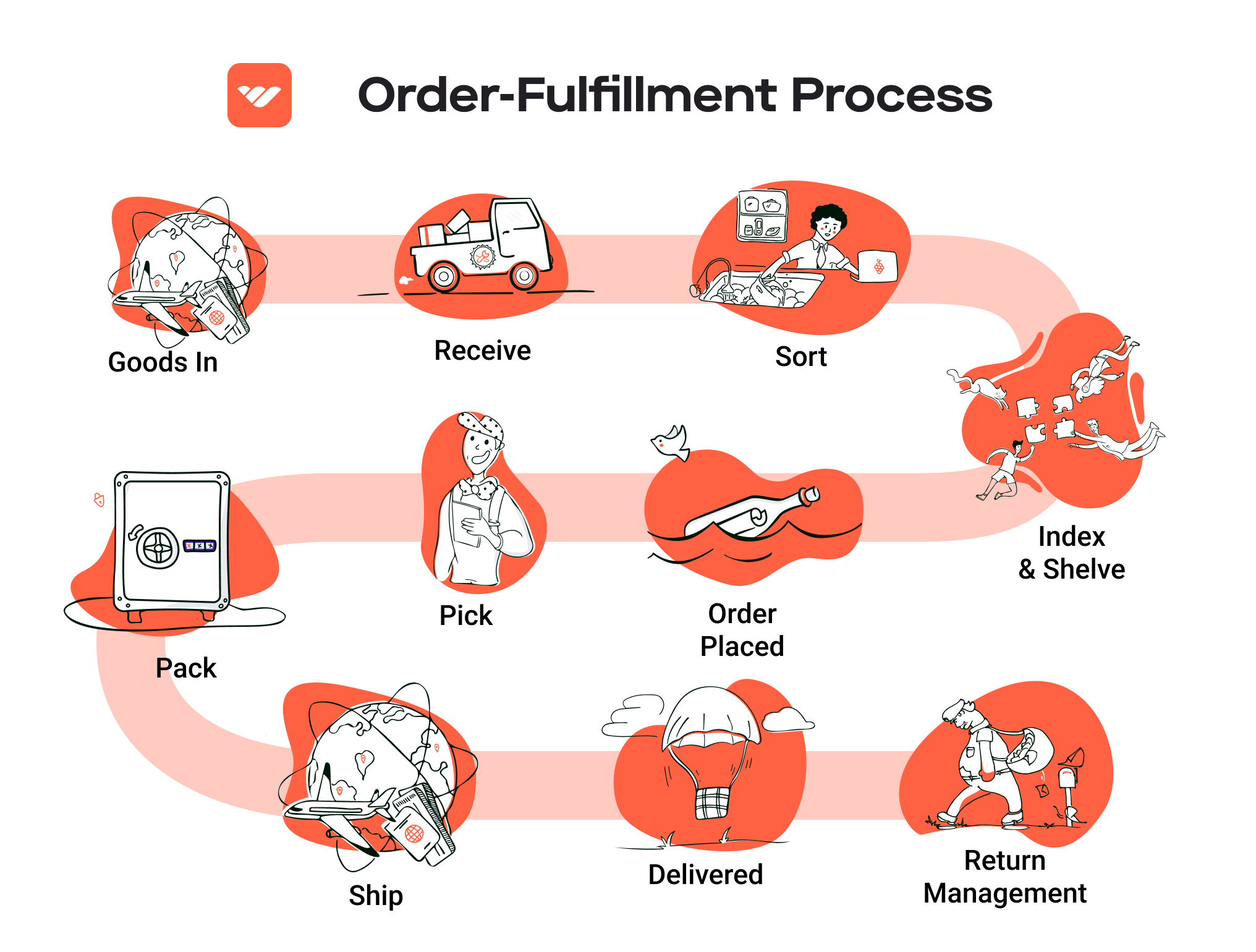
-
Product Storage: The inventory is stored in Amazon’s warehouses until an order is placed. Amazon manages the inventory, allowing sellers to track stock levels and sales performance through their Seller Central account.
-
Order Fulfillment: When a customer places an order, Amazon picks the item from the warehouse, packs it, and ships it directly to the customer. This process is usually completed within 24 hours, ensuring fast delivery.
-
Customer Service and Returns: Amazon handles customer service inquiries and returns for FBA products, freeing sellers from these responsibilities. This includes managing customer feedback and returns processing.
Pros of Using FBA
-
Prime Eligibility: Products fulfilled by Amazon are automatically eligible for Amazon Prime, which provides sellers access to a large customer base that values fast shipping. This can significantly increase sales and visibility.
-
Customer Trust: Selling through FBA enhances credibility. Customers are more likely to purchase items fulfilled by Amazon due to the trust associated with Amazon’s reliable shipping and customer service.
-
Multi-Channel Fulfillment: FBA allows sellers to fulfill orders not only from Amazon but also from their own websites and other platforms, providing flexibility in managing sales across various channels.
-
Scalability: FBA can handle large volumes of orders, making it easier for businesses to scale without the need to invest in additional warehousing and logistics infrastructure.
-
Reduced Workload: By outsourcing storage, packing, and shipping, sellers can focus on other aspects of their business, such as marketing, product development, and customer engagement.
Cons of Using FBA
-
High Fees: FBA comes with various fees, including storage fees for unsold inventory and fulfillment fees for each order shipped. These fees can add up quickly and reduce profit margins, particularly for low-cost items.
-
Strict Inventory Rules: Amazon enforces strict inventory management policies. Sellers must adhere to guidelines regarding storage limits, product preparation, and packaging standards. Failure to comply can result in additional fees or penalties.
-
Commingling Risks: FBA products may be commingled with similar products from other sellers. This means that a seller’s inventory could be mixed with that of another seller, leading to potential issues with quality control and brand integrity.
-
Less Control Over Fulfillment: While FBA simplifies logistics, it also means that sellers have less control over the fulfillment process. Issues such as shipping delays, incorrect orders, or damaged goods are managed by Amazon, which can affect seller reputation.
-
Dependency on Amazon: Relying on FBA means being subject to Amazon’s policies and algorithms, which can change. Any shifts in Amazon’s marketplace can have a direct impact on a seller’s business.
Who is FBA Best For?
Fulfillment by Amazon is best suited for:
-
Small to Medium-Sized Businesses: Companies that lack the resources to manage their own logistics can benefit significantly from FBA’s streamlined processes.
-
E-commerce Entrepreneurs: New sellers looking to enter the market quickly can leverage FBA’s infrastructure to gain access to Amazon’s vast customer base without extensive upfront investment.
-
Businesses with High Sales Volume: Companies that anticipate high sales volumes can take advantage of FBA’s scalability, allowing them to grow without the burden of managing fulfillment themselves.
-
Sellers with Seasonal Products: Businesses that experience fluctuations in demand can use FBA to scale up during peak seasons without the risk of overcommitting to warehousing costs during slower periods.
In conclusion, Fulfillment by Amazon offers a powerful platform for e-commerce businesses looking to streamline their operations and reach a broader audience. While it comes with its challenges, the benefits often outweigh the drawbacks for many sellers, making it an attractive option in the competitive e-commerce landscape.
Core Services Offered by Fulfillment Centers
Inventory Management & Warehousing
Inventory management and warehousing are foundational services provided by fulfillment centers. These centers offer dedicated storage space for products, allowing businesses to optimize their inventory levels without the overhead costs associated with maintaining their own warehouse. Fulfillment centers utilize advanced inventory management systems that track stock levels in real-time, ensuring that businesses always know what they have on hand.
The benefits of effective inventory management include improved cash flow, reduced storage costs, and enhanced order accuracy. By outsourcing these operations, e-commerce businesses can focus on their core competencies, such as marketing and product development, while leaving the complexities of inventory control to experts. This not only minimizes the risk of overstocking or stockouts but also allows businesses to scale efficiently during peak seasons, such as holidays or promotional events.
Pick and Pack Services
Pick and pack services are critical for e-commerce businesses that require efficient order fulfillment. This process involves selecting items from the warehouse based on customer orders and then packaging them for shipment. Fulfillment centers employ sophisticated picking systems, which may include automated technologies or manual processes, to ensure that orders are filled accurately and quickly.
The primary advantage of pick and pack services is the speed and efficiency they bring to the order fulfillment process. By leveraging the expertise of fulfillment centers, businesses can significantly reduce lead times, leading to higher customer satisfaction. Additionally, these services often include quality checks before shipping, minimizing returns due to incorrect or damaged items. For e-commerce businesses aiming to enhance their competitive edge, utilizing pick and pack services can be a game-changer, enabling them to offer faster shipping options and improve overall operational efficiency.
Kitting and Assembly
Kitting and assembly services are designed for businesses that sell products requiring bundling or assembly before shipping. This could involve grouping related items together as a kit or assembling components into a final product. Fulfillment centers provide the necessary labor and expertise to manage these complex tasks, allowing e-commerce businesses to offer customizable products or promotional bundles without the need to invest in additional labor or equipment.
The benefit of kitting and assembly services is the ability to streamline the production process and reduce lead times. For instance, a business that sells DIY kits can rely on fulfillment centers to pre-assemble the kits, ensuring that customers receive a ready-to-use product. This not only enhances the customer experience but also allows businesses to differentiate themselves in a crowded marketplace. By outsourcing these services, companies can maintain flexibility in their offerings and respond quickly to market demands without incurring significant operational costs.
Returns Management (Reverse Logistics)
Returns management, also known as reverse logistics, is an essential service offered by fulfillment centers, especially in the e-commerce sector where return rates can be high. This process involves handling returned products, assessing their condition, restocking them if possible, or facilitating their disposal or recycling. Effective returns management is crucial for maintaining customer satisfaction and loyalty, as a seamless return process can enhance the overall shopping experience.
The benefits of robust returns management include improved customer retention and reduced operational costs. By outsourcing this function to fulfillment centers, e-commerce businesses can streamline their return processes, ensuring that returns are processed quickly and efficiently. This not only minimizes the hassle for customers but also allows businesses to recover valuable inventory and reduce losses associated with unsold goods. Moreover, fulfillment centers often employ data analytics to identify trends in returns, enabling businesses to make informed decisions about product quality and customer preferences, ultimately leading to improved product offerings and reduced return rates.
In summary, fulfillment centers provide a suite of core services that are vital for e-commerce businesses looking to scale their operations. By leveraging these services—inventory management and warehousing, pick and pack, kitting and assembly, and returns management—businesses can enhance efficiency, improve customer satisfaction, and focus on growth without the burdens of logistics.
How to Choose a Fulfillment Partner: A 6-Point Checklist
Location & Warehouse Network
Importance: The geographic location of your fulfillment partner is critical for efficient logistics. A partner with warehouses strategically located near your customer base can significantly reduce shipping times and costs, enhancing customer satisfaction.
Questions to Ask:
– Where are your warehouses located, and how do they align with our customer demographics?
– What is your shipping coverage area?
– Can you provide insights into your average shipping times to various regions?
Technology & Integrations
Importance: In today’s fast-paced e-commerce landscape, technology plays a pivotal role in order fulfillment. A fulfillment partner should offer robust technology solutions that integrate seamlessly with your existing systems, such as your e-commerce platform, inventory management system, and customer relationship management (CRM) software.
Questions to Ask:
– What technology platforms do you use for order processing and inventory management?
– Can your system integrate with our existing e-commerce platform? If so, what is the process?
– Do you offer real-time tracking and reporting tools for inventory and order status?
Specializations (e.g., cold storage, oversized items)
Importance: Depending on your product offerings, you may require specialized fulfillment services. If you sell perishable goods, for example, you’ll need a partner with cold storage capabilities. Similarly, if you handle oversized or bulky items, ensure the partner can accommodate such requirements.
Questions to Ask:
– What types of products do you specialize in fulfilling?
– Do you have facilities that can handle temperature-sensitive products?
– How do you manage the storage and shipping of oversized items?
Scalability & Capacity
Importance: As your business grows, your fulfillment partner should be able to scale operations to meet increasing demand. This includes having the capacity to handle seasonal spikes in orders without compromising service quality.
Questions to Ask:
– How do you manage peak seasons or unexpected increases in order volume?
– What is your current capacity, and how do you plan to scale in the future?
– Can you provide examples of how you’ve successfully scaled for other clients?
Pricing and Contracts
Importance: Understanding the cost structure and terms of service is crucial for your budgeting and financial forecasting. Look for transparency in pricing and ensure there are no hidden fees. Evaluate the flexibility of contracts, particularly if your business model is likely to change.
Questions to Ask:
– Can you break down your pricing structure, including storage fees, pick and pack fees, shipping costs, and any additional charges?
– What are the terms of your contracts? Are there options for short-term agreements?
– How do you handle price adjustments for shipping rates or service changes?
Customer Support & Reviews
Importance: Reliable customer support can be a lifeline when issues arise. Assess the level of support provided by the fulfillment partner, including availability and responsiveness. Additionally, researching reviews and testimonials can give you insights into the partner’s reputation and reliability.
Questions to Ask:
– What customer support channels do you offer (e.g., phone, email, chat)?
– What are your average response times for customer inquiries or issues?
– Can you provide references or case studies from current or past clients?
Conclusion
Choosing the right fulfillment partner can have a profound impact on your e-commerce business’s efficiency and customer satisfaction. By carefully evaluating potential partners against this checklist, you can ensure that you select a fulfillment provider that aligns with your operational needs and growth ambitions. Prioritize open communication and transparency throughout the selection process, as these factors will contribute significantly to a successful partnership.
Understanding Fulfillment Pricing: A Breakdown of Common Fees
Initial Setup Fees
When partnering with a fulfillment center, the first cost you may encounter is the initial setup fee. This fee is typically charged to cover the costs associated with onboarding your business into the fulfillment system. It may include inventory setup, software integration, and initial training. The amount can vary based on the complexity of your inventory and the fulfillment center’s operational requirements.
To calculate these fees, fulfillment centers often consider the number of SKUs (stock keeping units) you have, the complexity of your product packaging, and any specific customizations required for your orders. Make sure to request a detailed breakdown of what the setup fee includes to avoid unexpected costs.
Receiving Fees
Receiving fees are charged when your products arrive at the fulfillment center. This fee covers the labor and resources needed to unload, inspect, and store your inventory. The cost is generally calculated based on the volume of goods received, often measured in units or pallets.
Fulfillment centers may have different pricing models for receiving fees—some charge a flat rate per pallet, while others may charge based on the weight of the shipment. To minimize receiving fees, consider consolidating shipments to reduce the number of times your products are received.
Storage Fees (per pallet/bin)
Storage fees are incurred for holding your inventory within the fulfillment center. These fees are usually calculated on a monthly basis and can be based on the space your products occupy, measured in pallets or bins.
Typically, storage fees are tiered: the first few pallets may be charged at a lower rate, while additional pallets incur higher fees. Some fulfillment centers may also have seasonal pricing, which can increase during peak times like the holiday season. To control storage costs, regularly monitor your inventory levels and consider using inventory management software to optimize stock turnover.
Pick & Pack Fees (per item/order)
Pick and pack fees cover the labor involved in retrieving items from storage and packing them for shipment. These fees can vary significantly depending on the fulfillment center’s pricing model. They may charge a flat rate per order or a variable fee based on the number of items included in the order.
In addition to basic pick and pack fees, some centers may charge extra for special packing requirements, such as custom packaging or gift wrapping. To manage these costs, aim for bulk orders whenever possible, as this can lead to reduced pick and pack fees per item.
Shipping Fees
Shipping fees are one of the most variable and potentially costly aspects of fulfillment pricing. These fees cover the cost of transporting your products from the fulfillment center to your customers and can depend on various factors including the shipping method (standard, expedited, etc.), package weight, dimensions, and destination.
Fulfillment centers typically negotiate rates with carriers, which can lead to lower shipping costs than you might secure on your own. It’s essential to understand how your chosen fulfillment center calculates shipping fees and whether they pass on those costs directly or include them in their service fees.
Tips for Getting an Accurate Quote
-
Clarify Your Needs: Before requesting a quote, clearly define your fulfillment needs, including the types of products you sell, expected order volumes, and any special requirements for storage or handling.
-
Request Itemized Pricing: Always ask for a detailed breakdown of all potential fees. This will help you understand what you’re paying for and allow for easier comparisons between fulfillment centers.
-
Negotiate Terms: Don’t hesitate to negotiate terms with potential fulfillment partners. Many centers are willing to adjust their pricing based on your projected volume or commitment.
-
Consider Seasonal Variations: Be aware of how fulfillment pricing may change during peak seasons. Request information on any seasonal pricing adjustments that could impact your costs.
-
Evaluate Long-term Costs: Look beyond initial pricing to assess long-term costs associated with storage, shipping, and potential additional fees. This will provide a more comprehensive view of your total fulfillment expenses.
By understanding the various components of fulfillment pricing, you can make informed decisions that align with your business goals and budget, ultimately enhancing your operational efficiency as you scale.
Frequently Asked Questions (FAQs) about Fulfillment
1. Can you wear earbuds in an Amazon fulfillment center?
No, earbuds are not permitted in Amazon fulfillment centers. The policy was implemented for safety reasons, as management aims to minimize distractions and ensure that all employees can hear important announcements and warnings.
2. What is the rationale behind banning earbuds?
The primary rationale for banning earbuds is employee safety. The management has expressed concerns that wearing earbuds could prevent workers from hearing critical sounds in the fulfillment center, which may lead to accidents or injuries. Additionally, the ban aims to create a uniform policy that applies to all employees, regardless of their work area.
3. Are there any exceptions to the earbud policy?
Currently, there are no exceptions to the earbud policy in Amazon fulfillment centers. All employees must adhere to the same rules to maintain a consistent and safe work environment.
4. How does the earbud ban affect employee morale and productivity?
The earbud ban has been reported to negatively impact employee morale and productivity. Many employees have expressed that listening to music or audiobooks helps them stay engaged and motivated during their shifts. The absence of this option can lead to a more monotonous and less enjoyable work experience.
5. What is the difference between a warehouse and a fulfillment center?
A warehouse is primarily used for storage of goods, while a fulfillment center is designed to process and ship orders to customers. Fulfillment centers focus on quick order processing and delivery, often utilizing advanced technology and systems to manage inventory and logistics.
6. What is a Third-Party Logistics Provider (3PL)?
A Third-Party Logistics Provider (3PL) is a company that offers logistics services to businesses, including warehousing, order fulfillment, shipping, and transportation management. Partnering with a 3PL allows e-commerce businesses to outsource their logistics operations and focus on core activities like marketing and product development.
7. How much do fulfillment services cost?
The cost of fulfillment services varies widely based on factors such as order volume, storage space requirements, and the complexity of the logistics involved. Generally, businesses can expect to pay for storage fees, picking and packing fees, shipping costs, and any additional services they may require. It’s advisable to obtain quotes from multiple fulfillment service providers to compare pricing and services.
8. What are the key benefits of using a fulfillment center?
Using a fulfillment center provides several benefits, including faster shipping times, improved inventory management, scalability for growing businesses, and the ability to focus on core business activities instead of logistics. Fulfillment centers also often have established relationships with shipping carriers, which can lead to cost savings.
9. How can I improve employee morale in a fulfillment center?
Improving employee morale can involve a variety of strategies, such as fostering open communication, recognizing and rewarding performance, offering professional development opportunities, and creating a positive work environment. Implementing wellness programs or providing resources for mental health can also be beneficial.
10. What should I consider when choosing a fulfillment partner?
When selecting a fulfillment partner, consider factors such as their experience and reputation, technology and systems used, shipping options and costs, scalability to accommodate growth, customer service, and the ability to handle your specific product needs. It’s important to conduct thorough research and potentially visit the facility to ensure it aligns with your business goals.
Conclusion: Is Outsourcing Fulfillment the Right Move for Your Business?
The Case for Outsourcing Fulfillment
Outsourcing your fulfillment processes can be a strategic move that significantly enhances your e-commerce operations. One of the most compelling benefits of utilizing a fulfillment service is the time saved. By delegating inventory management, packing, and shipping to an experienced partner, you can redirect your focus towards scaling your business and enhancing customer engagement. This shift allows you to invest more time in strategic initiatives, product development, and marketing efforts that directly contribute to revenue growth.
Another key advantage is scalability. As your business grows, so do your fulfillment needs. A reputable fulfillment partner can easily accommodate fluctuations in order volume, whether during peak seasons or unexpected surges in demand. This flexibility ensures that you can meet customer expectations without the burden of managing logistics in-house, which can often lead to operational bottlenecks and diminished service quality.
Additionally, outsourcing fulfillment provides access to specialized expertise. Fulfillment centers are equipped with advanced technology and experienced personnel who understand the intricacies of logistics, compliance, and inventory management. This expertise can lead to improved accuracy, faster shipping times, and ultimately, higher customer satisfaction—critical elements in today’s competitive e-commerce landscape.
However, the success of outsourcing hinges on selecting the right partner. Conduct thorough due diligence to ensure that your chosen fulfillment service aligns with your business objectives and values. Look for partners who prioritize transparency, offer tailored solutions, and demonstrate a commitment to customer service.
Call to Action
Take the first step towards optimizing your operations by auditing your current shipping process. Evaluate your efficiency, costs, and customer satisfaction levels. Consider whether a fulfillment partner could alleviate your logistical challenges and support your growth aspirations. The right partnership could be the key to unlocking your business’s full potential.
Important Disclaimer
⚠️ Important Disclaimer
The information in this guide is for educational purposes. Fulfillment services, pricing, and platform features change frequently. Always conduct your own due diligence and consult with providers directly before making business decisions.
